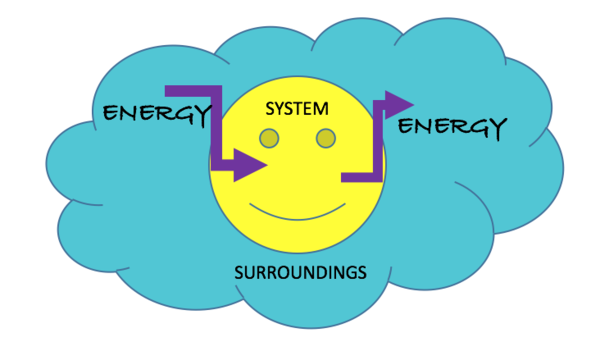System & Surroundings
Main Idea
When it comes to energy, choosing what is the system versus what is the surroundings has profound affects on what needs to be accounted for when solving for various values/variables. Choosing certain objects to be a part of the system rather than the surroundings can have an extreme effect on the outcome of said variables, especially when the surroundings do a fairly large amount of work on the system.
By definition, a system is a specific part of the universe that we choose to study and analyze, while the surroundings are everything else that 'surrounds,' and typically has a significant effect on, the system. This page will analyze how different choices of systems can affect the components of the Energy Principle when relating it to the system.
Mathematical Model
The mathematical model related to choice of system focuses on the The Energy Principle.
Types of Energy Systems
- 1. An Open Energy System
- An Open Energy System is subject to changes in it's internal energy as a result of energy transfers between the system and its surroundings. These transfers could be either into the system or out of the system and as a result [math]\displaystyle{ \mathbf{\vartriangle}E_{system} }[/math] could be negative or positive. The total energy of an open system is therefore not constant. For instance, when you boil rice in an open saucepan on a stove, energy is being transferred to the surroundings in the form of steam. The open saucepan is an example of an open system, and as steam escapes to the surroundings there is loss of thermal energy from the system (remember [math]\displaystyle{ \mathbf{\vartriangle}E_{system} }[/math] is not constant).
- 2. A Closed Energy System
- A Closed Energy System is not subject to changes in its internal energy. Therefore:
- [math]\displaystyle{ \mathbf{\vartriangle}E_{system} = 0 }[/math]
- Although energy transfers between the system and surroundings exist, the amount of energy inflow is equal to the amount of energy outflow, and therefore the net change in energy is equal to zero. An example of a closed system could be a thermos flask. If ice cubes and boiling water are placed into the thermos at the same time, there would an increase in the energy of the ice cubes and an equal decrease in the energy of the boiling water, resulting in the net change of energy to be zero. However, it is important to note that no system can be perfectly closed, and there would be negligible leakage of energy to the surroundings form the thermos flask as it is not perfectly insulated.
The Energy Principle
- To first understand the impact of the choice of system, it is best to fully understand the Energy Principle. The Energy Principle is based on the fact that energy is a conserved quantity in the universe, meaning that it cannot be created nor destroyed, only transferred. This definition of the conservation of energy gives us the equation:
- [math]\displaystyle{ \mathbf{\vartriangle}E_{system} + \mathbf{\vartriangle}E_{surroundings} = 0 }[/math]
- The following image best illustrates the idea that since energy is a conserved quantity, systems may only gain/lose energy if the surroundings lose/gain that same amount of energy.
- The Energy Principle can then be rearranged by using the fact that the change in energy of a specific system is equal to the work done on the system by the surroundings, or:
- [math]\displaystyle{ \mathbf{\vartriangle}E_{system} = W }[/math], where
- [math]\displaystyle{ \mathbf{\vartriangle}E_{system} = E_f - E_i }[/math] (The final energy of the system minus the initial energy of the system)
- This facts gives:
- [math]\displaystyle{ E_f = E_i + W }[/math]
- The above equation is what we will primarily use when accounting for all of the energy terms when the choice of system/surroundings changes.
Computational Model
Using VPython, we can analyze a number of open and closed energy systems. The following code will follow the energy and thus the motion of a sphere attached to a pendulum in a closed system situation, as well as an open system situation. The length of the rope is [math]\displaystyle{ L = 1 \ \text{m} }[/math], the mass of the sphere is [math]\displaystyle{ m = 0.5 \ \text{kg} }[/math], the initial velocity of the sphere is [math]\displaystyle{ \mathbf{v}_0 = \mathbf{0} \ \frac{m}{s} }[/math], and the initial angle to the vertical is [math]\displaystyle{ \theta_0 = 30^\text{o} }[/math]. In the open energy system, an air resistance force will do work against the sphere's motion, given by the following: [math]\displaystyle{ F_{air} = 0.3v^2 }[/math], where [math]\displaystyle{ v }[/math] is the speed of the sphere.
from __future__ import division
from visual import *
from visual.graph import *
scene.center = (0,-0.5,0)
top = sphere(pos = vector(0,0,0), radius = 0.01)
LENGTH OF STRING
L = 1
INITIAL ANGLE
theta = 30 * pi/180
THE GRAVITATIONAL CONSTANT IN SCALAR FORM
gg = 9.8
THE GRAVITATIONAL CONSTANT IN VECTOR FORM
g = vector(0,-9.8,0)
balla = sphere(pos = L*vector(sin(theta), -cos(theta),0), radius = 0.1, color = color.cyan)
balla.m = 0.5
balla.p = vector(0,0,0)
traila = curve(color = color.yellow)
stringa = cylinder(pos = top.pos, axis = (balla.pos - top.pos), radius = 0.01)
ballb = sphere(pos = L*vector(sin(theta), -cos(theta),0), radius = 0.1, color = color.red)
ballb.m = 0.5
ballb.p = vector(0,0,0)
trailb = curve(color = color.green)
stringb = cylinder(pos = top.pos, axis = (ballb.pos - top.pos), radius = 0.01)
t = 0
dt = 0.001
while t < 10:
rate(1000)
#Calculate the vector from balla to the top
ra = top.pos - balla.pos
#Fnet is graviational plus tension
#v is the scalar velocity
va = mag(balla.p)/balla.m
#calculate the magnitude of the ball's acceleration
balla.a = (va**2)/L
#theta is the angular position of the ball
thetaa = atan(balla.pos.x/(-balla.pos.y))
#calculate the vector tension force
Ta = (balla.m * gg * cos(thetaa) + balla.m * balla.a) * norm(ra)
#calculate the net force
Fneta = balla.m * g + Ta
#update momentum of ball
balla.p = balla.p + Fneta * dt
#update position of ball
balla.pos = balla.pos + balla.p * dt / balla.m
#update the string
stringa.axis = balla.pos - top.pos
traila.append(balla.pos)
Ea = balla.m * gg * balla.pos.y + (1/2) * balla.m * (mag(balla.p)/balla.m)**2
if t > 9.5:
print(Ea)
rb = top.pos - ballb.pos
#Fnet is graviational plus tension minus the air resistance
#v is the scalar velocity
vb = mag(ballb.p)/ballb.m
#calculate the magnitude of the ball's acceleration
ballb.a = (vb**2)/L
#theta is the angular position of the ball
thetab = atan(ballb.pos.x/(-ballb.pos.y))
#calculate the vector tension force
Tb = (ballb.m * gg * cos(thetab) + ballb.m * ballb.a) * norm(rb)
#calculate air resistance
F_air = 0.3 * (vb)**2 * norm(ballb.p)
#calculate the net force
Fnetb = ballb.m * g + Tb - F_air
#update momentum of ball
ballb.p = ballb.p + Fnetb * dt
#update position of ball
ballb.pos = ballb.pos + ballb.p * dt / ballb.m
#update the string
stringb.axis = ballb.pos - top.pos
trailb.append(ballb.pos)
Eb = ballb.m * gg * ballb.pos.y + (1/2) * ballb.m * (mag(ballb.p)/ballb.m)**2
if t > 9.9:
print(Eb)
t = t+dt
Examples
Simple
Middling
Difficult
Connectedness
History
See also
Further reading
External links
References
Choice of System
Although physical results are always consistent, choosing different objects as the system changes the form of the energy equation that needs to be used, and which energy terms must be included in order to calculate accurate values for unknowns. In the following example, a fairly complex system will be analyzed in several different ways. Each of these will show a different choice of system and surroundings and how this effects the Energy Principle.
Example
In this example, a man is lifting his child in the air straight above his head as shown in the picture below. Two different choices of system will be analyzed, one in which the man, child, and Earth are all the system and the other where just the child is the system. By analyzing these two scenarios, it will become much clearer how the specific choice of system varies how equations are formed and calculations are carried out.
1) Man, Child, and the Earth
In this first situation, the system consists of the man, the child, and the Earth, while there is nothing deemed significant enough to include in the surroundings. In the intial state, the child is at rest, while in the final state the child has moved up above the man's head a distance, d, and has a specific velocity, v. Since there is nothing significant in the surroundings, the work is equal to 0. This gives the following equation:
Ef = Ei + W Kf + Uf + Eman,f = Ki + Ui + Eman,i +W Kf + mgd + Eman,f = 0 + 0 + Eman,i + 0 Eman,f - Eman,i = -(Kf + mgd) ∆Eman = -(Kf +mgd)
The formula for kinetic energy can then be used to solve for the change in energy of the man.
2) Child
In the second situation, the child is the only object in the system, which means that the man and the Earth are the surroundings. The initial and final conditions are the same as in the previous analysis, so the child still moves a distance upward, d, with velocity, v. The only difference is now that there are significant objects in the surroundings, the term for work is no longer equal to zero since both of these objects have an impact on the object. An equation for this situation can be found below:
Ef = Ei + W Kf = Ki + Wman + W earth Kf = 0 + Fd - mgd Kf = Fd - mgd
By analyzing the systems/surroundings in these different ways, different variables can be found by relating the resulting equations to solve for unknowns. This sort of idea applies to many different situations involving energy, and it is very useful and necessary to be able to determine which factors must be included.
Energy Dissipation
The total energy of the Universe is constant, however, forms of energy can be converted into other less useful forms of energy. These less useful forms of energy is the energy that is dissipated and includes air resistance, sliding friction and viscous friction.
1)Air Resistance
Air resistance is caused by the friction of air against a moving object. It acts in the direction opposite to the motion of the object. Air Resistance depends on many things including speed, density and both the shape and cross sectional area of the moving object.
2)Viscous Friction
This is friction that occurs when extremely small particles such as dust fall slowly through thick liquids.
Connectedness
How Systems and Surroundings Relates to Your Major
Industrial Engineering
While this page refers mainly to thermodynamic and energy systems, I believe the concept of systems is essential to industrial engineers. Industrial Engineers work on making systems as efficient as possible by minimizing waste in the production process. They also merge people, machinery, information and energy to create a product or a service. People, machinery, information and energy can be considered a system. It is an industrial engineers job to figure out the most optimal way to merge parts of the system together in order to have the greatest impact or outflow from the system to the surroundings (consumers/customers). Industrial engineers work with open systems and strive towards having a net positive outflow (i.e the resources supplied produce greater output or value).
External links
Thinking about Physics Thinking by Professor Michael Schatz [1]
References
Matter and Interactions 4th Edition
Thinking about Physics Thinking
--Gnewville3 (talk) 22:39, 19 April 2016 (EDT)

